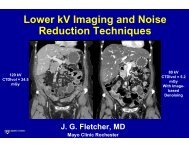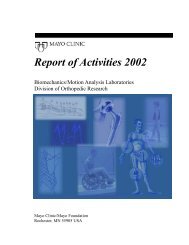Finding Optimal Cutpoints for Continuous ... - Research - Mayo Clinic
Finding Optimal Cutpoints for Continuous ... - Research - Mayo Clinic
Finding Optimal Cutpoints for Continuous ... - Research - Mayo Clinic
Create successful ePaper yourself
Turn your PDF publications into a flip-book with our unique Google optimized e-Paper software.
egression model setting respectively [6, 23]. These techniques will be described in Sections 3 &<br />
4 respectively.<br />
2b. Estimation of optimal cutpoint<br />
Determining the existence of a threshold effect and estimating an optimal cutpoint <strong>for</strong> a<br />
single continuous covariate uses a series of two-sample tests <strong>for</strong> the multiple possible candidate<br />
dichotomizations of the continuous covariate. The maximum number of candidate cutpoints is k-<br />
1, where k is the number of unique values of the continuous covariate. Some have suggested<br />
excluding the outer 10-20% of the continuous covariate distribution to avoid having small<br />
numbers in one of the groups following dichotomization, thereby preventing substantial losses in<br />
statistical power [1, 5, 6, 16, 17]. The inner 80-90% of the distribution from which a cutpoint is<br />
chosen is referred to as the selection interval. For each candidate cutpoint within a specified<br />
selection interval, an appropriate two-sample test with concomitant test statistic and p-value (Pc)<br />
is determined. A cutpoint model may be appropriate if any Pc is less than or equal to some pre-<br />
specified allowable level of Type I error. The optimal cutpoint is often defined as that candidate<br />
cutpoint with the smallest Pc. This method <strong>for</strong> estimating a cutpoint is referred to as the<br />
minimum p-value approach, or alternatively the maximum statistic approach [1]. Other criteria<br />
<strong>for</strong> choosing an optimal cutpoint have been suggested, including maximum effect size and<br />
maximum precision of estimates, but have received less support [6, 24].<br />
It is well recognized that Type I error rates <strong>for</strong> an optimal cutpoint found via the<br />
minimum p-value approach can be substantially inflated as a result of multiple comparisons [3,<br />
4, 6, 10, 14, 18]. That is, the likelihood of finding a significant association at significance level<br />
α between a chosen cutpoint and outcome when in reality no relationship exists is likely to be<br />
much higher than α. This inflation rises as the number of candidate cutpoints examined<br />
5




